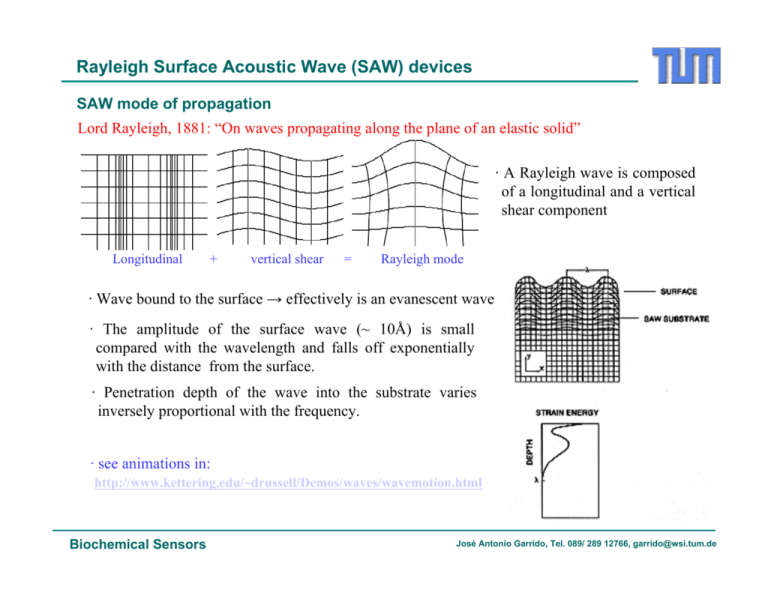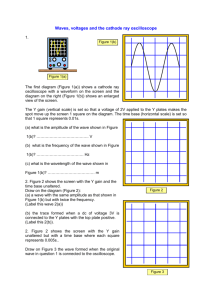Rayleigh Surface Acoustic Wave (SAW) devices
advertisement

Rayleigh Surface Acoustic Wave (SAW) devices SAW mode of propagation Lord Rayleigh, 1881: “On waves propagating along the plane of an elastic solid” · A Rayleigh wave is composed of a longitudinal and a vertical shear component Longitudinal + vertical shear = Rayleigh mode · Wave bound to the surface → effectively is an evanescent wave · The amplitude of the surface wave (~ 10Å) is small compared with the wavelength and falls off exponentially with the distance from the surface. · Penetration depth of the wave into the substrate varies inversely proportional with the frequency. · see animations in: http://www.kettering.edu/~drussell/Demos/waves/wavemotion.html Biochemical Sensors José Antonio Garrido, Tel. 089/ 289 12766, garrido@wsi.tum.de Surface Acoustic Wave (SAW) device White, Voltmer 1965: “Direct piezoelectric coupling to surface acoustic waves” · Interdigitated (IDT) thin-film metal electrodes deposited on top of a piezoelectric substrate · When a potential is applied to an IDT, it causes a periodic displacement of the surface ( and also a surface potential wave!). VR ≡ velocity of the Rayleigh wave (3158 m/s for ST-cut quartz) f0 = VR λ = VR 4d Biochemical Sensors d ≡ finger and gap width ≡ resonance frequency José Antonio Garrido, Tel. 089/ 289 12766, garrido@wsi.tum.de Surface Acoustic Wave (SAW) device Oscillator circuit · Delay: a) delay between applied electric field and displacement b) Delay due to propagation time c) Delay in the amplifier ω= · Attenuation (2nπ − ϕe )VR L Mass sensitivity · Any factor affecting VR will change the resonance frequency f0 ∆υ υ0 = ⎤ 1 ⎡ ∂υ ∂υ ∂υ ∂υ ∂υ ... ∆ + ∆ + σ ∆ + m c T p ∆ + ∆ ⎥ ∂c υ0 ⎢⎣ ∂m ∂T ∂σ ∂p ⎦ p ≡ pressure T ≡ temperature m ≡ surface mass c ≡ surface stiffness σ ≡ surface conductivity Biochemical Sensors José Antonio Garrido, Tel. 089/ 289 12766, garrido@wsi.tum.de Surface Acoustic Wave (SAW) device Mass sensitivity Wohltjen (Sens. Actuat. 1984, Vol5, pg 307 ) → assuming the presence of a thin (h<<λ), lossless, isotropic, insulating film: ∆m ∆f = CS f − kf 02ξ ( µ ,η ) A 2 0 CS ≡ mass sensitivity (~ 1,35 x 10-6 cm2 s g-1 of the substrate for quartz) · SAW devices can be operated at high frequencies (25 – 500 MHz), and therefore the sensitivity (Hz g-1) is higher. higher frequency of operation by reducing the finger and ∆f 2 gap width of the interdigitated tranducers. ∝ f ∆m 0 in principle SAW could be operated to give mass sensitivities down to the fg (10-15 g) level ! main disadvantage : Rayleigh SAW devices cannot be operated in liquids · the out-of-plane component (shear vertical) couples into the liquid and generates a compressional wave. ↔ very efficient process Biochemical Sensors José Antonio Garrido, Tel. 089/ 289 12766, garrido@wsi.tum.de Surface Acoustic Wave (SAW) device Sensor design chemically selective coating RF AMP RF AMP Signal measurements · Attenuation (two port IDT) reference path · Delay or Phase shift (two port IDT) · Resonance frequency (one port IDT) mixer signal sensitive path Biochemical Sensors José Antonio Garrido, Tel. 089/ 289 12766, garrido@wsi.tum.de Surface Acoustic Wave (SAW) device Sensor design chemically selective coating RF AMP RF AMP Signal measurements · Attenuation (two port IDT) reference path · Delay or Phase shift (two port IDT) · Resonance frequency (one port IDT) mixer signal sensitive path Biochemical Sensors José Antonio Garrido, Tel. 089/ 289 12766, garrido@wsi.tum.de Acustoelectric response · The evanescent electric field associated with the acoustic wave is coupled to the surroundings’ charge carriers. · Acustoelectric coupling results in: i) Wave velocity decrease ii) Attenuation Biochemical Sensors In contrast, mass loading produces a linear decrease of velocity José Antonio Garrido, Tel. 089/ 289 12766, garrido@wsi.tum.de The cochlear amplifier is a SAW amplifier standing acoustic wave Hensen’s strip pressure variations of the cochlear fluids The gap between the OHC determines the wavelength Inner Hair Cells Outer Hair Cells (3 rows) · Incoming sound energy, transmitted as pressure variations of the cochlear fluid, is sensed and amplified by the three rows of OHCs, which can sense deflection of their sterocilia or of pressure. The cell body of OHC can change length almost instantaneously. · The three rows of OHC has the same function that the IDT of a SAW device. By reacting to the sound energy, a standing wave, ripples at the surface of the tectorial membrane, is generated · Hensen’s stripe is ideally placed to absorb acoustic energy from the resonant cavity and deliver it to the stereocilia of the Inner Hair Cells (IHC) underneath. Biochemical Sensors José Antonio Garrido, Tel. 089/ 289 12766, garrido@wsi.tum.de Shear Horizontal Acoustic Plate Mode (SH-APM) ·Pseudo surface waves, horizontally polarized bulk shear waves in a thin piezoelectric plate ·The surface displacement of the SH wave is in the plane of the substrate surface → no out-ofplane displacement Wave motion not damped by contact with a liquid 100 – 150 MHz Mass sensitivity ∆f = Cf 0 ρ C∝ 1 ∆f ∝ f 02 at high frequency b 13-50 MHz sensitivity weakly frequency dependent when compared to QCM or Rayleigh SAW (200 µm-thick) Biochemical Sensors SH can operate with the sensing liquid and the IDTs on opposite sides of the plate avoiding the problem of electrical coupling between the electrodes José Antonio Garrido, Tel. 089/ 289 12766, garrido@wsi.tum.de Shear Horizontal Acoustic Plate Mode (SH-APM) biosensors Development of a Surface Acoustic Wave Immunosensor, Welsch et al, Anal. Chem. 1996, 68, 2000-2004 ·In liquid operation at 345 MHz ·Immunoglobulin (IgG) antibodies immobilized on the sensitive path · Antigen detection: · detection limit of about 33 pg · sensitivity of 110 kHz/ (ng/mm2) 20 µL injections (2.1 µg/ µL ) a) saturation of sensitive layer Biochemical Sensors b) frequency dependence → viscosity effect ? José Antonio Garrido, Tel. 089/ 289 12766, garrido@wsi.tum.de Lamb wave – Flexural Plate Mode (FPM) devices · Special case of the Rayleigh wave, in which the thickness of the medium in which it propagates is of the order of the wavelength metal · The finger spacing (and thus the frequency) are chosen to fulfill that the thickness of the FPM is thin compared to the wavelength · Particle displacements for Lamb waves are elliptical as with Rayleigh wave longitudinal and shear-vertical components symmetric mode antisymmetric mode The FPW is arranged with respect to electrical IDT excitation so that only antisymmetric or flexural waves are propagated in the device Biochemical Sensors José Antonio Garrido, Tel. 089/ 289 12766, garrido@wsi.tum.de Lamb wave – Flexural Plate Mode (FPM) devices · The propagation velocity is quite different from that of Rayleigh waves, allowing lower frequency of operation (5MHz) · Velocity of flexural wave is significantly slower than the compressional velocity of sound in liquids · The compressional (or evanescent) wave induced into a fluid in contact with the device does not excessively attenuate the wave motion ⎡ ⎤ B υ = k⎢ ⎥ M + ( ρ K / k ) ⎢⎣ ⎥⎦ f K = 1 − (υ υ f ) 2 1 2 k = 2π / λ K /k =δ λ ⎡⎢ ⎛⎜ υ δ ≡ evanescent wave ≡ 1− 2π ⎢ ⎜⎝ υ f penetration distance ⎣ B ≡ effective plate stiffness ρ f ≡ density of the loaded fluid ⎞ ⎟ ⎟ ⎠ 2 ⎤ ⎥ ⎥ ⎦ 1 2 M ≡ unloaded mass increases in both mass loading of the membrane (adsorption) and fluid density (gel formation, melting/freezing of the fluid) will modify the acoustic wave velocity and will produce a frequency shift · Advantages of FPM: - High sensitivity - Flexibility of detection at either surface ∆f = S m f∆m ∆m = ρδ typically S m ≡ 950 Biochemical Sensors cm2 g-1 at 2.6MHz · Disadvantages of FPM: - Fabrication cost (membrane fabrication) - Device fragility José Antonio Garrido, Tel. 089/ 289 12766, garrido@wsi.tum.de Love wave devices also known as surface-skimming bulk wave Conventional SH device with a guiding layer deposited on it · The energy of the bulk wave is concentrated in the guiding layer due to its lower shear acoustic velocity · The amount of energy transferred into the layer depends on the thickness and the acoustic properties of the layer. ∆f = C (l , h ) fρ C (l , h ) ≡ The sensitivity is a function of guiding layer material (l) and thickness (h) · Love wave sensors have the advantage of SH devices (no losses in liquids) and a better sensitivity to mass loading (due to the concentration of the wave near the surface) QCM (10MHz) → 0.23 Hz µg-1 SH-SAW (158MHz) → 1.2 Hz µg-1 Love (110MHz) Biochemical Sensors → 26.4 Hz µg-1 José Antonio Garrido, Tel. 089/ 289 12766, garrido@wsi.tum.de Love wave devices Influence of guiding layer thickness · As the thickness of the layer increases more of the bulk wave is concentrated in that layer, and therefore the sensitivity increases limit ~ 0.2 ng/cm2 · At a certain thickness the layer does no longer behaves as a thin layer but as a plate, and the wave energy decreases along with the sensitivity. · Important: the acoustic attenuation of the layer determines the propagated energy to a receiving IDT Biochemical Sensors José Antonio Garrido, Tel. 089/ 289 12766, garrido@wsi.tum.de Viscous loading contribution · Lord Rayleigh (1929) predicted that shear waves propagating at a solid-liquid interface would be attenuated by the viscous loading of the fluid. ∆f ∝ (πf 0ηρ ) 12 η ≡ liquid viscosity ρ≡ liquid density · The viscous wave generated at the interface decays within the liquid. −z ξ ξ = (η πf 0 ρ )1 2 if η↑, the shear wave penetrates further into the liquid e , Biochemical Sensors José Antonio Garrido, Tel. 089/ 289 12766, garrido@wsi.tum.de







